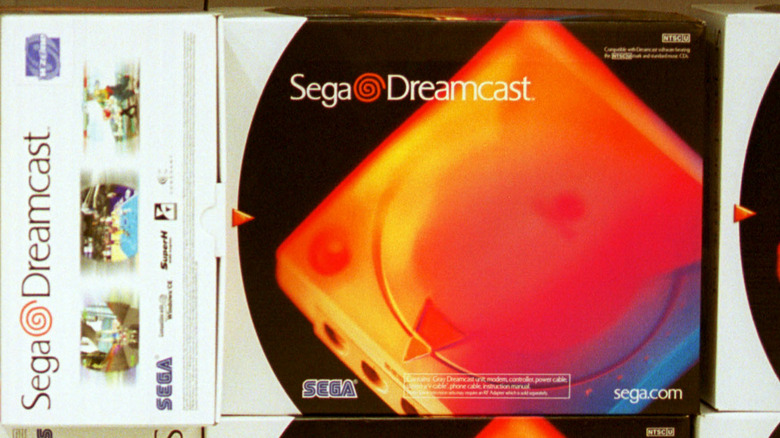Sega Was Ahead Of Its Time With The Dreamcast And It Backfired
Sega is one of the most well-known video game publishers in the world, but there was a time when it was a preeminent console maker as well. The pinnacle of its success in the hardware market was with the Sega Genesis, which was the only console to give Nintendo a run for its money before Sony and Microsoft entered the field, but Sega was never quite the same after that. It released the Sega 32X, the Sega Saturn, and the Sega Dreamcast -– all of which ultimately failed to reach the same heights as the Genesis.
The failure of the Sega Dreamcast was a particularly sore loss for the company. Things were looking up for the console in the beginning. Its North American launch in 1999 set an industry record by selling more than 225,000 units in consoles and games combined and pulling in $98.4 million in total revenue in the first 24 hours but was dead just 19 months later as sales quickly dropped off (per Game Developer).
There were a number of contributing factors that led to the console's demise, but in spite of its many failings, the Dreamcast had several features that were way ahead of their time.
A unique memory card
One thing that players who bought the Dreamcast noticed as soon as they opened the box was the way it handled storage. Unlike the simple memory cards that most consoles used, the Dreamcast came with something called the VMU, or visual memory unit. This would plug directly into the controller and could be used by the player to save the game –- but it also did so much more. All it took was a glance to know that it was way more advanced than the memory units on other consoles.
Happy #SegaSaturday🥳
This is the small but mighty #Dreamcast VMU, an interactive extension and essential part of the console setup that also doubles as a memory card and portable consoleAhead of it's time?#gamers #GamersUnite #retrogamer #retrogames #RETROGAMING #SEGA #Retro pic.twitter.com/eHSsUltiUI
— Dynamic-Gaming-Twinz (@TwinzDynamic) November 12, 2022
The VMU wasn't a simple chunk of plastic for players to plug in and forget about. It had a tiny screen and a set of control buttons on it. The screen could be used as a secondary display set into the controller while it was connected to the console, but it could also be used as its own separate handheld gaming device to play mini-games.
Many of the titles that were released on the Dreamcast, like the "Sonic Adventure" games, contained the software to upload new minigames onto the VMU where they could be played independently from the Dreamcast itself. Most of these were pretty simple and the battery on the VMU was notoriously short lived, but some of them went on to become beloved fan favorites.
This feature wasn't enough to save the Dreamcast, but it was certainly innovative, and gamers can see echoes of the technology in later consoles like the Wii U.
Online gaming
The Genesis was the first console to develop online capabilities, but it required users to buy an external modem attachment, and even then, online gameplay was incredibly simplistic and was viewed by most as more of a gimmick than anything. There were only a handful of games with online capabilities, and they were limited by the slow internet speeds of the time. The Dreamcast was the first console to come with its own ISP and a modem for connecting to the internet built into the console. Sega put a ton of resources into developing its online capabilities.
The Sega Dreamcast broadband modem. Released late in the life of the system and hella expensive now, but a big improvement over dialup. pic.twitter.com/l0AZwZC0gJ
— Evan Amos (@VanamoMedia) February 12, 2017
This is why it was so devastating for the company when it lost the support of third-party developers such as EA (per Eurogamer). Sports games like "Madden" were the bread and butter of Sega's plan for making use of the Dreamcast's online capabilities. To combat this, Sega made its own line-up of sports titles, like "NFL 2K1," which were largely marketed based on their ability to allow players to challenge rival fans online.
Unfortunately, it seems that this didn't provide the draw that Sega thought it would. Console gamers were much more interested in features like the PlayStation 2's built-in DVD player than they were in online gameplay at the time. Online console gaming wouldn't truly take off until five years later when the next generation of consoles launched.
The first to implement DLC
Online play wasn't the only way that Sega made use of the Dreamcast's internet connectivity. It was also the first console to introduce downloadable content, much of which can still be accessed through online archives such as dreamcast live. This was revolutionary at the time, as developers modifying games after release had only ever been available on PC.
Former Sega executive Bernie Stolar stated at the 1999 Game Developers Conference, (via The Ringer,) "Dreamcast is as alive as the games you develop," referring to the way the Dreamcast set the stage for the consoles that followed, and suggesting that its legacy remains in the way it has helped shape modern game development.
Gamers these days have grown accustomed to day-one patches, DLC expansions, and in-game stores, but it wasn't always that way. There was a time when the disk or cartridge that came in the case was all players would get. Bugs couldn't be fixed after launch and new content would usually only ever come in the form of a sequel. The ability to modify games over the internet has made it possible for developers to patch, grow and continue to alter their games years after their initial release and, for better or worse, it was the Sega Dreamcast that paved the way — even if players weren't quite ready for it.




